
Black-browed albatross in flight, at sea. The black-browed albatross is a medium-sized seabird at 31-37" long with a 79-94" wingspan and an average weight of 6.4-10 lb. They have a natural lifespan exceeding 70 years. They breed on remote oceanic islands and are circumpolar, ranging throughout the Southern Ocean.
Species: Black-browed albatross, Thalassarche melanophrys
Location: Falkland Islands, United Kingdom
Image ID: 24012
Species: Black-browed albatross, Thalassarche melanophrys
Location: Falkland Islands, United Kingdom
Image ID: 24012

Southern giant petrel in flight at dusk, after sunset, as it soars over the open ocean in search of food.
Location: Falkland Islands, United Kingdom
Image ID: 24013
Location: Falkland Islands, United Kingdom
Image ID: 24013

Black-browed albatross in flight, at sea. The black-browed albatross is a medium-sized seabird at 31-37" long with a 79-94" wingspan and an average weight of 6.4-10 lb. They have a natural lifespan exceeding 70 years. They breed on remote oceanic islands and are circumpolar, ranging throughout the Southern Ocean.
Species: Black-browed albatross, Thalassarche melanophrys
Location: Falkland Islands, United Kingdom
Image ID: 24014
Species: Black-browed albatross, Thalassarche melanophrys
Location: Falkland Islands, United Kingdom
Image ID: 24014
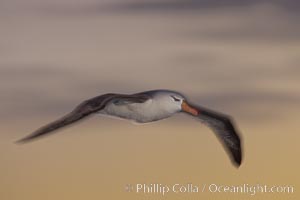
Black-browed albatross in flight, at sea. The black-browed albatross is a medium-sized seabird at 31-37" long with a 79-94" wingspan and an average weight of 6.4-10 lb. They have a natural lifespan exceeding 70 years. They breed on remote oceanic islands and are circumpolar, ranging throughout the Southern Ocean.
Species: Black-browed albatross, Thalassarche melanophrys
Location: Falkland Islands, United Kingdom
Image ID: 24015
Species: Black-browed albatross, Thalassarche melanophrys
Location: Falkland Islands, United Kingdom
Image ID: 24015

Black-browed albatross in flight, at sea. The black-browed albatross is a medium-sized seabird at 31-37" long with a 79-94" wingspan and an average weight of 6.4-10 lb. They have a natural lifespan exceeding 70 years. They breed on remote oceanic islands and are circumpolar, ranging throughout the Southern Ocean.
Species: Black-browed albatross, Thalassarche melanophrys
Location: Falkland Islands, United Kingdom
Image ID: 24016
Species: Black-browed albatross, Thalassarche melanophrys
Location: Falkland Islands, United Kingdom
Image ID: 24016
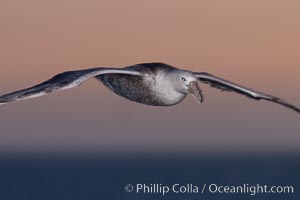
Black-browed albatross in flight, at sea. The black-browed albatross is a medium-sized seabird at 31-37" long with a 79-94" wingspan and an average weight of 6.4-10 lb. They have a natural lifespan exceeding 70 years. They breed on remote oceanic islands and are circumpolar, ranging throughout the Southern Ocean.
Species: Black-browed albatross, Thalassarche melanophrys
Location: Falkland Islands, United Kingdom
Image ID: 24018
Species: Black-browed albatross, Thalassarche melanophrys
Location: Falkland Islands, United Kingdom
Image ID: 24018

Black-browed albatross in flight, at sea. The black-browed albatross is a medium-sized seabird at 31-37" long with a 79-94" wingspan and an average weight of 6.4-10 lb. They have a natural lifespan exceeding 70 years. They breed on remote oceanic islands and are circumpolar, ranging throughout the Southern Ocean.
Species: Black-browed albatross, Thalassarche melanophrys
Location: Falkland Islands, United Kingdom
Image ID: 24019
Species: Black-browed albatross, Thalassarche melanophrys
Location: Falkland Islands, United Kingdom
Image ID: 24019
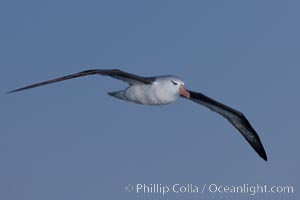
Black-browed albatross in flight, at sea. The black-browed albatross is a medium-sized seabird at 31-37" long with a 79-94" wingspan and an average weight of 6.4-10 lb. They have a natural lifespan exceeding 70 years. They breed on remote oceanic islands and are circumpolar, ranging throughout the Southern Ocean.
Species: Black-browed albatross, Thalassarche melanophrys
Location: Falkland Islands, United Kingdom
Image ID: 24020
Species: Black-browed albatross, Thalassarche melanophrys
Location: Falkland Islands, United Kingdom
Image ID: 24020

Black-browed albatross in flight, at sea. The black-browed albatross is a medium-sized seabird at 31-37" long with a 79-94" wingspan and an average weight of 6.4-10 lb. They have a natural lifespan exceeding 70 years. They breed on remote oceanic islands and are circumpolar, ranging throughout the Southern Ocean.
Species: Black-browed albatross, Thalassarche melanophrys
Location: Falkland Islands, United Kingdom
Image ID: 24022
Species: Black-browed albatross, Thalassarche melanophrys
Location: Falkland Islands, United Kingdom
Image ID: 24022

Black-browed albatross in flight, at sea. The black-browed albatross is a medium-sized seabird at 31-37" long with a 79-94" wingspan and an average weight of 6.4-10 lb. They have a natural lifespan exceeding 70 years. They breed on remote oceanic islands and are circumpolar, ranging throughout the Southern Ocean.
Species: Black-browed albatross, Thalassarche melanophrys
Location: Falkland Islands, United Kingdom
Image ID: 24023
Species: Black-browed albatross, Thalassarche melanophrys
Location: Falkland Islands, United Kingdom
Image ID: 24023

Southern giant petrel in flight. The distinctive tube nose (naricorn), characteristic of species in the Procellariidae family (tube-snouts), is easily seen.
Location: Falkland Islands, United Kingdom
Image ID: 24024
Location: Falkland Islands, United Kingdom
Image ID: 24024
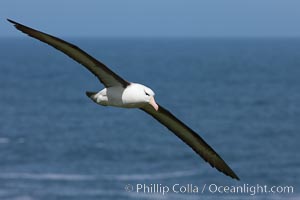
Black-browed albatross, in flight over the ocean. The wingspan of the black-browed albatross can reach 10', it can weigh up to 10 lbs and live for as many as 70 years.
Species: Black-browed albatross, Thalassarche melanophrys
Location: Steeple Jason Island, Falkland Islands, United Kingdom
Image ID: 24079
Species: Black-browed albatross, Thalassarche melanophrys
Location: Steeple Jason Island, Falkland Islands, United Kingdom
Image ID: 24079

Black-browed albatross in flight, over the enormous colony at Steeple Jason Island in the Falklands.
Species: Black-browed albatross, Thalassarche melanophrys
Location: Steeple Jason Island, Falkland Islands, United Kingdom
Image ID: 24080
Species: Black-browed albatross, Thalassarche melanophrys
Location: Steeple Jason Island, Falkland Islands, United Kingdom
Image ID: 24080

Wandering albatross in flight, over the open sea. The wandering albatross has the largest wingspan of any living bird, with the wingspan between, up to 12' from wingtip to wingtip. It can soar on the open ocean for hours at a time, riding the updrafts from individual swells, with a glide ratio of 22 units of distance for every unit of drop. The wandering albatross can live up to 23 years. They hunt at night on the open ocean for cephalopods, small fish, and crustaceans. The survival of the species is at risk due to mortality from long-line fishing gear.
Species: Wandering albatross, Diomedea exulans
Location: Southern Ocean
Image ID: 24088
Species: Wandering albatross, Diomedea exulans
Location: Southern Ocean
Image ID: 24088

Wandering albatross in flight, over the open sea. The wandering albatross has the largest wingspan of any living bird, with the wingspan between, up to 12' from wingtip to wingtip. It can soar on the open ocean for hours at a time, riding the updrafts from individual swells, with a glide ratio of 22 units of distance for every unit of drop. The wandering albatross can live up to 23 years. They hunt at night on the open ocean for cephalopods, small fish, and crustaceans. The survival of the species is at risk due to mortality from long-line fishing gear.
Species: Wandering albatross, Diomedea exulans
Location: Southern Ocean
Image ID: 24089
Species: Wandering albatross, Diomedea exulans
Location: Southern Ocean
Image ID: 24089
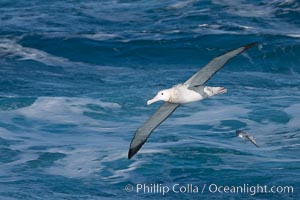
Wandering albatross in flight, over the open sea. The wandering albatross has the largest wingspan of any living bird, with the wingspan between, up to 12' from wingtip to wingtip. It can soar on the open ocean for hours at a time, riding the updrafts from individual swells, with a glide ratio of 22 units of distance for every unit of drop. The wandering albatross can live up to 23 years. They hunt at night on the open ocean for cephalopods, small fish, and crustaceans. The survival of the species is at risk due to mortality from long-line fishing gear.
Species: Wandering albatross, Diomedea exulans
Location: Southern Ocean
Image ID: 24090
Species: Wandering albatross, Diomedea exulans
Location: Southern Ocean
Image ID: 24090

Prions in flight, gathering on the open sea in a feeding aggregation. Prions are small petrel birds, typically feeding on small crustacea such as copepods, ostracods, decapods, and krill, as well as some fish. They are about 12" in length.
Species: Prion, Pachyptila
Location: Southern Ocean
Image ID: 24091
Species: Prion, Pachyptila
Location: Southern Ocean
Image ID: 24091

Black-browed albatross soaring in the air, near the breeding colony at Steeple Jason Island.
Species: Black-browed albatross, Thalassarche melanophrys
Location: Steeple Jason Island, Falkland Islands, United Kingdom
Image ID: 24105
Species: Black-browed albatross, Thalassarche melanophrys
Location: Steeple Jason Island, Falkland Islands, United Kingdom
Image ID: 24105
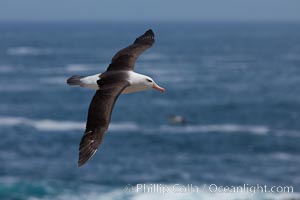
Black-browed albatross, in flight over the ocean. The wingspan of the black-browed albatross can reach 10', it can weigh up to 10 lbs and live for as many as 70 years.
Species: Black-browed albatross, Thalassarche melanophrys
Location: Steeple Jason Island, Falkland Islands, United Kingdom
Image ID: 24106
Species: Black-browed albatross, Thalassarche melanophrys
Location: Steeple Jason Island, Falkland Islands, United Kingdom
Image ID: 24106

Black-browed albatross soaring in the air, near the breeding colony at Steeple Jason Island.
Species: Black-browed albatross, Thalassarche melanophrys
Location: Steeple Jason Island, Falkland Islands, United Kingdom
Image ID: 24111
Species: Black-browed albatross, Thalassarche melanophrys
Location: Steeple Jason Island, Falkland Islands, United Kingdom
Image ID: 24111

Black-browed albatross, in flight over the ocean. The wingspan of the black-browed albatross can reach 10', it can weigh up to 10 lbs and live for as many as 70 years.
Species: Black-browed albatross, Thalassarche melanophrys
Location: Steeple Jason Island, Falkland Islands, United Kingdom
Image ID: 24112
Species: Black-browed albatross, Thalassarche melanophrys
Location: Steeple Jason Island, Falkland Islands, United Kingdom
Image ID: 24112

Black-browed albatross soaring in the air, near the breeding colony at Steeple Jason Island.
Species: Black-browed albatross, Thalassarche melanophrys
Location: Steeple Jason Island, Falkland Islands, United Kingdom
Image ID: 24113
Species: Black-browed albatross, Thalassarche melanophrys
Location: Steeple Jason Island, Falkland Islands, United Kingdom
Image ID: 24113
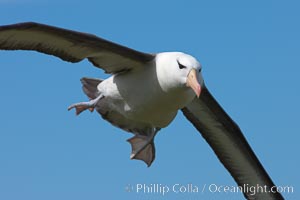
Black-browed albatross in flight, against a blue sky. Black-browed albatrosses have a wingspan reaching up to 8', weigh up to 10 lbs and can live 70 years. They roam the open ocean for food and return to remote islands for mating and rearing their chicks.
Species: Black-browed albatross, Thalassarche melanophrys
Location: Steeple Jason Island, Falkland Islands, United Kingdom
Image ID: 24114
Species: Black-browed albatross, Thalassarche melanophrys
Location: Steeple Jason Island, Falkland Islands, United Kingdom
Image ID: 24114

Black-browed albatross in flight, against a blue sky. Black-browed albatrosses have a wingspan reaching up to 8', weigh up to 10 lbs and can live 70 years. They roam the open ocean for food and return to remote islands for mating and rearing their chicks.
Species: Black-browed albatross, Thalassarche melanophrys
Location: Steeple Jason Island, Falkland Islands, United Kingdom
Image ID: 24116
Species: Black-browed albatross, Thalassarche melanophrys
Location: Steeple Jason Island, Falkland Islands, United Kingdom
Image ID: 24116

Black-browed albatross in flight, against a blue sky. Black-browed albatrosses have a wingspan reaching up to 8', weigh up to 10 lbs and can live 70 years. They roam the open ocean for food and return to remote islands for mating and rearing their chicks.
Species: Black-browed albatross, Thalassarche melanophrys
Location: Steeple Jason Island, Falkland Islands, United Kingdom
Image ID: 24118
Species: Black-browed albatross, Thalassarche melanophrys
Location: Steeple Jason Island, Falkland Islands, United Kingdom
Image ID: 24118

Wandering albatross in flight, over the open sea. The wandering albatross has the largest wingspan of any living bird, with the wingspan between, up to 12' from wingtip to wingtip. It can soar on the open ocean for hours at a time, riding the updrafts from individual swells, with a glide ratio of 22 units of distance for every unit of drop. The wandering albatross can live up to 23 years. They hunt at night on the open ocean for cephalopods, small fish, and crustaceans. The survival of the species is at risk due to mortality from long-line fishing gear.
Species: Wandering albatross, Diomedea exulans
Location: Southern Ocean
Image ID: 24133
Species: Wandering albatross, Diomedea exulans
Location: Southern Ocean
Image ID: 24133

Black-browed albatross in flight, against a blue sky. Black-browed albatrosses have a wingspan reaching up to 8', weigh up to 10 lbs and can live 70 years. They roam the open ocean for food and return to remote islands for mating and rearing their chicks.
Species: Black-browed albatross, Thalassarche melanophrys
Location: Southern Ocean
Image ID: 24139
Species: Black-browed albatross, Thalassarche melanophrys
Location: Southern Ocean
Image ID: 24139

Black-browed albatross in flight, over the enormous colony at Steeple Jason Island in the Falklands.
Species: Black-browed albatross, Thalassarche melanophrys
Location: Steeple Jason Island, Falkland Islands, United Kingdom
Image ID: 24142
Species: Black-browed albatross, Thalassarche melanophrys
Location: Steeple Jason Island, Falkland Islands, United Kingdom
Image ID: 24142

Black-browed albatross in flight, over the enormous colony at Steeple Jason Island in the Falklands.
Species: Black-browed albatross, Thalassarche melanophrys
Location: Steeple Jason Island, Falkland Islands, United Kingdom
Image ID: 24143
Species: Black-browed albatross, Thalassarche melanophrys
Location: Steeple Jason Island, Falkland Islands, United Kingdom
Image ID: 24143

Black-browed albatross in flight, against a blue sky. Black-browed albatrosses have a wingspan reaching up to 8', weigh up to 10 lbs and can live 70 years. They roam the open ocean for food and return to remote islands for mating and rearing their chicks.
Species: Black-browed albatross, Thalassarche melanophrys
Location: Steeple Jason Island, Falkland Islands, United Kingdom
Image ID: 24145
Species: Black-browed albatross, Thalassarche melanophrys
Location: Steeple Jason Island, Falkland Islands, United Kingdom
Image ID: 24145